The last day of November was unusually warm and air temperatures actually reached double figures. I was fishing the Herefordshire Arrow at Court of Noke with the trotting rod and was pleased to get two specimen grayling in the bag along with others of all different sizes. This is the sort of mix we like to see with the health and future of the fishery in mind. A few large dark olives were hatching, although I saw no corresponding rises. Meanwhile TP from Woodbridge fished the neighbouring Lugg at Lyepole and had 9 grayling to 12 inches. Next day AM from Worcester with a friend was at Court of Noke and recorded 7 grayling to 2 pounds, while MB from Llanhilleth fished the Monnow at Skenfrith on the 3rd and accounted for 9 grayling on nymphs. I note that Skenfrith winter fishing results have been improving lately. AP from the Wirral fished at Lyepole on the same day and recorded 14 grayling to 15 inches.
 Court of Noke in winter
Court of Noke in winter 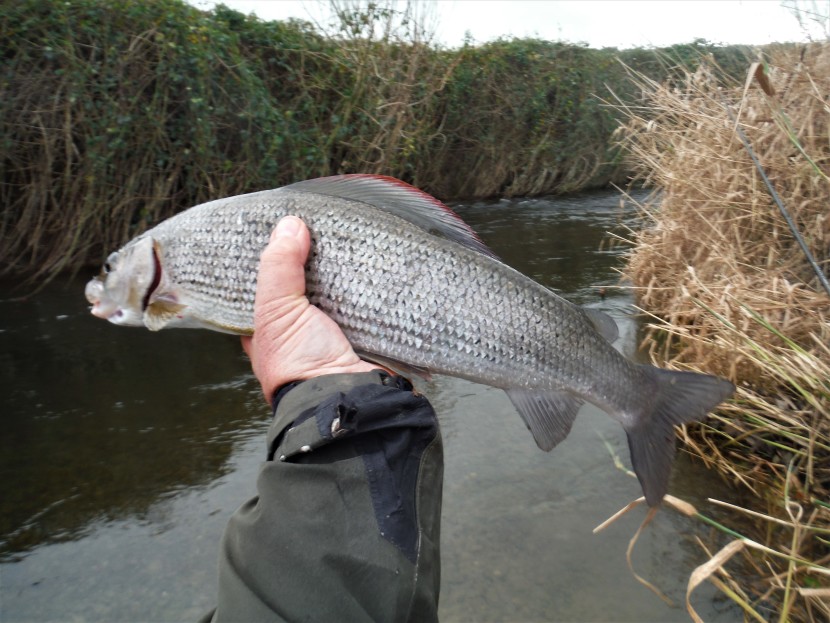 Court of Noke trotting swim
Court of Noke trotting swim Full marks then for the tributaries, but that was the signal for the weather to turn quite unpleasant for the first time this winter and instead of mild days we experienced low temperatures, icy showers and blustery winds. On the 5th AH from Whitchurch fished at Lyepole, where he caught his first grayling – that is to say he caught a small, but of course we understand a very significant, fish. This was all by the way; the main purpose of his visit, he tells us, was to treat his partner at the Riverside Inn in nearby Aymestrey. Fair enough, AH, if we want to keep the chance to go a-fishing, brownie points must be earned on occasion. This is a lesson most of us have learned over time. AP from Wirral was back on Lyepole again on the 7th and recorded 7 grayling. Shortly after this angling came to a halt everywhere due to heavy rain and flooding on all our rivers. This scenario is exactly what we do not want at this season; preferable would have been dry, frosty weather and low rivers which would have suited grayling anglers and encouraged successful salmon spawning.
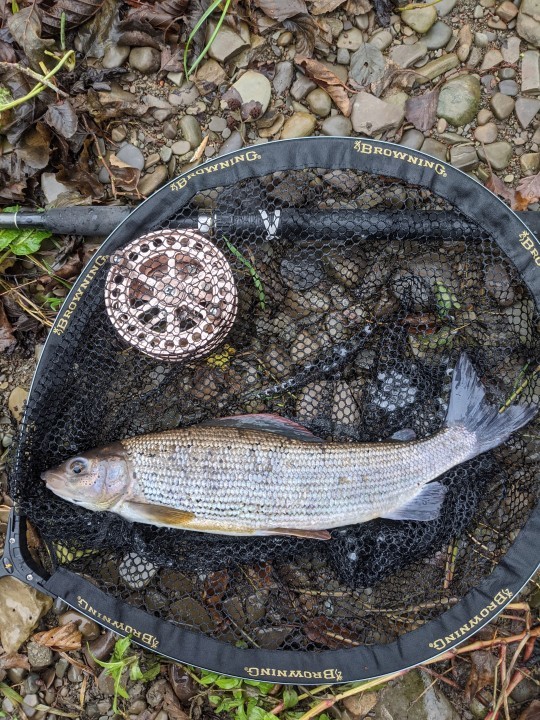 Lyepole grayling - AP from Wirral
Lyepole grayling - AP from Wirral 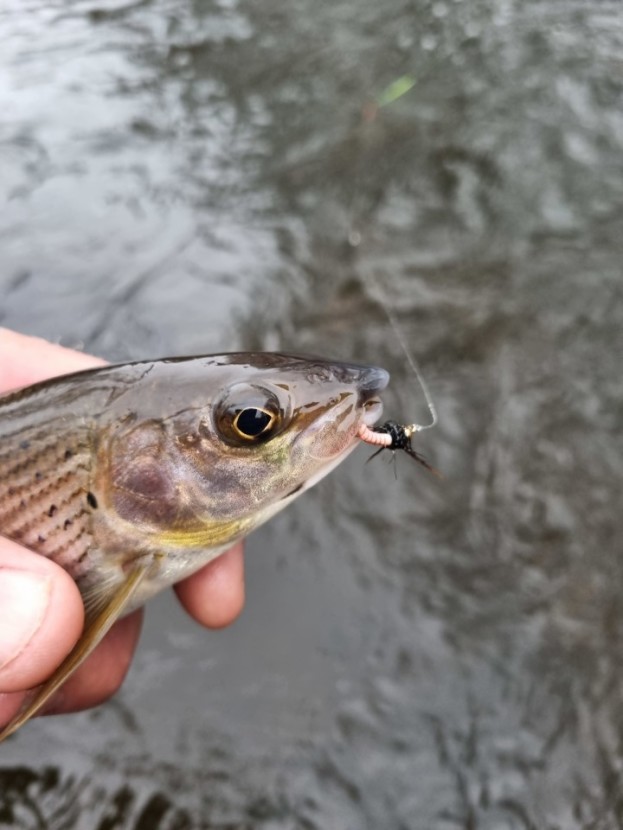 Skenfrith grayling - MB from Llanhilleth
Skenfrith grayling - MB from Llanhilleth Incidentally, there has been much talk this year of the need to protect salmon redds in order to maximise the spawning potential of different parts of the system. As an angler occasionally for both species I certainly approve of that concern and would not wish to oppose the idea. Winter grayling anglers have altogether been relatively open to suggestions to avoid damage to eggs in the gravel and have quite willingly switched to trotting rather than nymph fishing on certain beats regarded as critical. However, let’s not get over-zealous about this as I gather some posters on the wilder shores of the salmon angling fora have been doing lately. Grayling anglers are not yet asking salmon anglers to withhold from wading in March, April and May to protect the grayling spawning gravels of spring, although I suppose that day might come. There is more than one species of fish in the Wye; let’s try to look after them all.
 Middle Hill Court pike - IH from Bryncoch
Middle Hill Court pike - IH from Bryncoch Unfortunately the cold, grey, drizzly weather continued for a couple more weeks. The showers were enough to keep the rivers up and rule out fishing, until levels began to fall slightly in the second half of the month. Thus on the 18th JD from Bromyard caught 7 grayling to 16 inches on Abernant. (Going completely off piste for a moment, I have to slip in here a picture from IH from Bryncoch holding a 20 pounds pike taken around this time from the lower Wye’s Middle Hill Court. On occasion I have seen such monsters following the spinner when salmon fishing at nearby Goodrich Court. It’s enough to put you off wading!) On the 19th SD from Alcester fishing the Creel reported an out of season sea trout along with his bag of half a dozen chub. This capture was something rare, but not unknown. On the same day IA with a friend fished the top of the Irfon at the Colonel’s Water and opined that there is not a big stock of grayling up here. I think he may be right about that, but there are a few good ones if you can manage to bump into them. The previous day my pal Lyn Davies managed to do this with some rather deep wading in an awkward place – see Lyn’s pictures of two 40cm fish. The car park at this beat, by the way, is in an appalling state at the moment, being full of mud. I also had a good if very cold day with David Burren fishing at Cefnllysgywnne on the 21st, the shortest day of the year. We were both trotting and the smallest fish of our modest in numbers bag of 13 was 15 inches and the largest 18 inches, so the average size was remarkable. As before, there was that concern about where the younger generations of grayling might be. But again, out the following day with Rory Findlay on the main Wye at Abernant, after a certain amount of casting around to locate the fish and being forced to deal with high water in a very poor light, Rory eventually had a steady stream of 10 inch grayling coming to his nymphs.
 Grayling from the Colonel's water - Lyn Davies
Grayling from the Colonel's water - Lyn Davies  Peas in a pod - second grayling from the Colonel's Water, Lyn Davies
Peas in a pod - second grayling from the Colonel's Water, Lyn Davies Rain on Christmas night and again on Boxing Day brought the rivers up again. That was a shame because, for many of us, those odd free days around Christmas and the New Year are a great opportunity to go grayling fishing. I can remember landing at Heathrow from foreign parts just before the holidays began and immediately ringing the Foundation to book up all the beats I could find, including Clochfaen which I fished on New Year’s Day. I did catch grayling from an ice-fringed river and watched the great salmon paired in one of the deep pools. That must have been 20 years ago. The rain continued after the holiday although the air temperature rose back into double figures again. I’m getting past being surprised by unusual weather; we seem to break temperature records every year now. Writing this on the last day of December, I don’t yet have access to the holiday fishing reports, but given the height of the rivers, I don’t expect there will be many.
 Nymphing the Upper Irfon
Nymphing the Upper Irfon 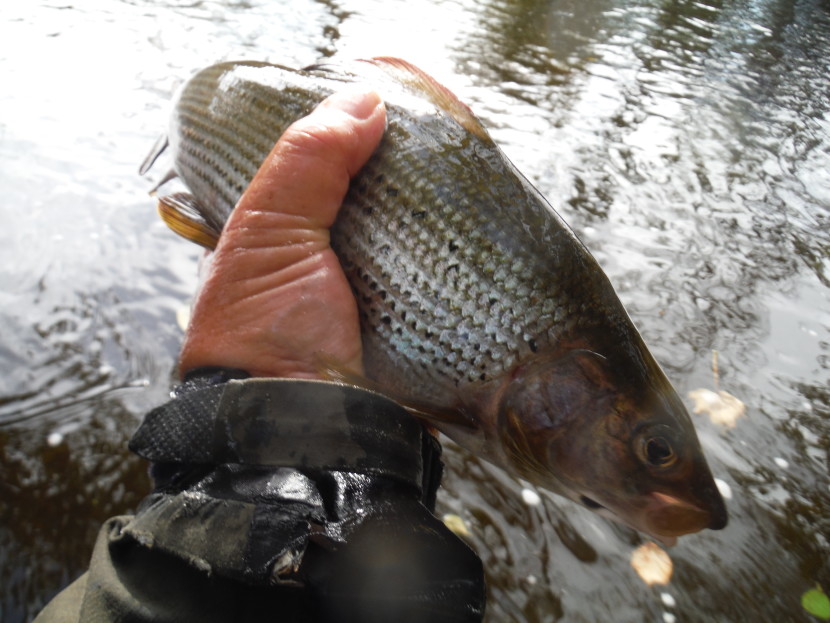 Cammarch Hotel grayling
Cammarch Hotel grayling A big autumn gale, this one named Arwen, came through towards the end of November. This was a bad storm for some of us, causing damage and even loss of life, but even so there was something exciting about it. I went for a walk along the ridge at the top of Rough Raging Wood. These are shooting woods of the local estate without, strictly speaking, public access, but there is a line of big chestnuts I wanted to see tossing their heads. Rough Raging is another good example of the colourful names our Forest forerunners gave to their surroundings. Not far away are Hanging Wood, Old Bargain Wood, the Devil’s Chapel and Heaven’s Gate. Despite the cold it was an exhilarating morning, with black rain clouds blowing fast up the estuary and obscuring distant hill tops. Our son Zlatko came home to Ross after working all night on power outages and crashed into bed…only to find on waking that his own power was off! Storm Barra, which followed up a few days later, gave a hard pounding to the Atlantic coast of Ireland, but had lost its full predicted strength by the time it reached us. There were a couple more before the year ended.
As residents of the British Isles, these famously storm-blown outposts moored off-shore from the continent, we should all of us be quite used to living with winds and tempests. Storms do cause us damage every year, that is for sure, but in our temperate British climate they rarely last more than 48 hours. Rod in hand in normal times I rather enjoy a wind for all sorts of reasons. For example I certainly like one when lake fishing, if it is at least enough to put a good ripple on the surface. Drifting a boat or fishing the bank of an upland lake, I claim the existence of a good breeze, even a proper stiff breeze, will double the chances for takes. Even with lowland pools, the wind touching the water usually helps. I can remember a late autumn day on Beanhill Lake when a strong, steady breeze to the head of the lake had ruffled the surface everywhere to a matt grey colour, like newly cut steel. No doubt the water was cooling and taking on oxygen rapidly. And yet every now and then, you could see a little upwelling of smooth water breaking the pattern of ripples. These were caused by rainbow trout which were cruising upwind taking little winter midges as they hatched. The fishing was tremendously exciting. I used a 9 foot rod and a double taper 5 weight floating line, a 16 foot leader with tiny Pheasant Tail Nymphs, size 16 or 18, and fished across the wind and just under the surface, letting it all pull round in a curve. The takes, when they came, were dramatic, sometimes throwing spray as the line pulled tight. There was really no need to strike. Rain will do no harm either, given the right clothing, although I know anglers who say they don’t do well in rain.
Oddly enough I also find I enjoy a wind when shooting, although others would disagree. One of my shooting grounds is exposed on a high ridge above the Wye and in a gale the nearby turbine sometimes spins with terrifying speed as if the propeller is about to run away from the shaft. Of course rain is unwelcome in the receiver mechanism of the gun or, even worse, rain wetting the cartridges to risk a slow burn, but a gusty dry wind making high targets jinx and veer in unpredictable directions just adds to the fun. What we don’t have in Britain are regular and predictable winds, although there is a general expectation of equinoctial gales in spring and autumn. An autumn gale is a moving experience, as AE Housman knew when writing about our border country. He used the image to expose the unquiet spirit of men through the centuries, from the Roman city of Uricon to 19th century Shropshire:
On Wenlock Edge the wood’s in trouble;
His forest fleece the Wrekin heaves;
The gale, it plies the saplings double,
And thick on Severn snow the leaves.
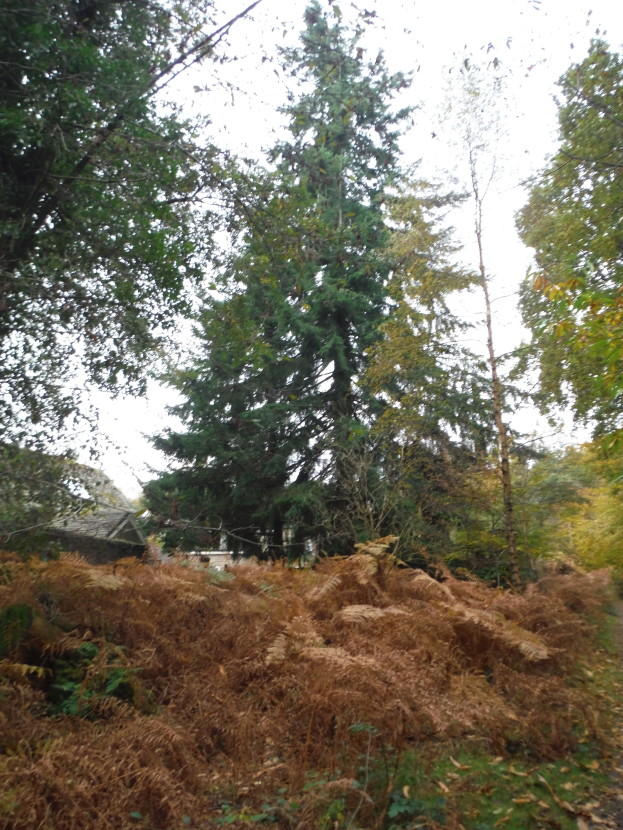 The last Danby pine
The last Danby pine When my sister and I were children, a wind-break clump of tall pines stood behind our grandmother’s house. This was isolated from any other building, all alone on top of a forested hill, with a distant view from upper windows of the shining Severn and the dim blue Cotswolds beyond. When approaching along a mile of gravel track you could not see the house itself until close at hand, but the tall pines on the crest of the hill, higher than any other trees, marked the spot for many miles in all directions. The 17th century forester’s lodge was one of six built in the Dean on the instructions of Samuel Pepys as Secretary to the Admiralty, this at a time when a pressing need for ship-building timber for Britain’s navy had become apparent. They were in fact guard-posts of the royal forest, defences against poachers and illegal logging. Danby Lodge, built of grey sandstone quarried from pits behind the house and with beams of darkened oak which look strong enough for a ship of the line’s keel, still stands firmly enough on its hill high above the valley of the Blackpool Brook and doubtless will for centuries to come. On a warm summer day then a child could walk into the dim cool of the stone flagged dining room with its great fireplace, and smell the wood smoke of three centuries, the leather of old furniture and hear the slow ticking of the grandfather clock. Walk into the empty fireplace and you could look up and see the sky. An ancient oak door beside the same fireplace opened onto a spiral stair case (one of two in the house) leading to the upper storeys and attic rooms, none of which had a true right angle in them. The house was full of old books and pictures. In my grandmother’s time (the family rented it from the Forestry Commission from 1928 to 1970) the Lodge lacked certain amenities such as electricity, running water, sanitation and central heating. Grandmother was a tough old girl, eccentric most would have said, and cared little for such modern luxuries.
That lack has been remedied by subsequent private owners and the interior of the house, although comfortable now without doubt, has been ruthlessly overhauled and lost most of its character in the process. Outside the overgrown gardens and orchards have been cleared to make way for austere lawns and a swimming pool. The pines are gone too, all but one, although the beech woods below remain. As children of the old house, however, we would go from the courtyard at the back of the kitchen by the laundry, past the well 70 feet deep, the stable with a block of steps for mounting horses, the kitchen garden, outside privy, woodshed haunted by pipistrelle bats, old pig sty and chicken run grown with nettles, and finally out through the back gate, just to sit under those pines on the summit of the hill above the miles of green forest and listen. The sound of the wind in the tops was exactly that of the sea, the sound you would hear when pressing your ear to a shell. The sound was always there, even on quiet summer days, but when the wind really blew it grew into a steady roar.
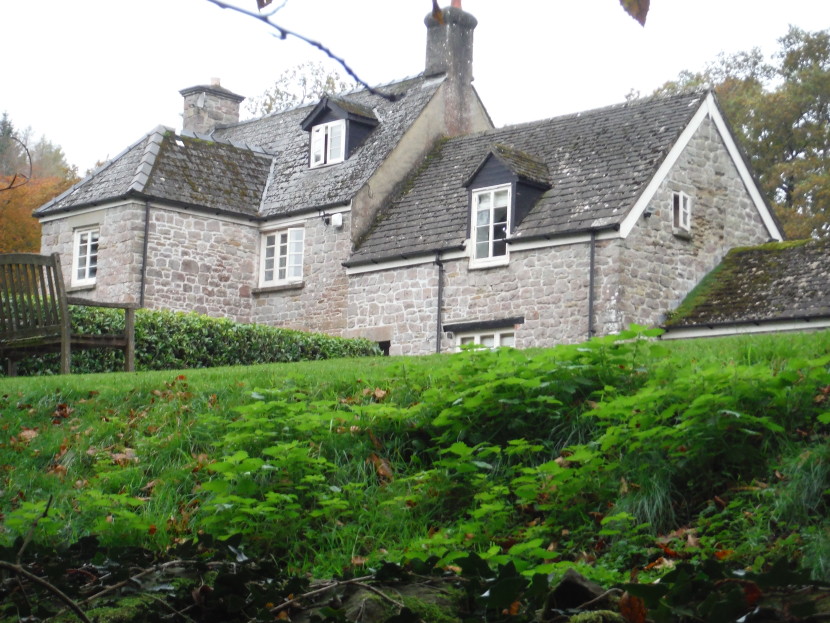 Danby Lodge 2021
Danby Lodge 2021 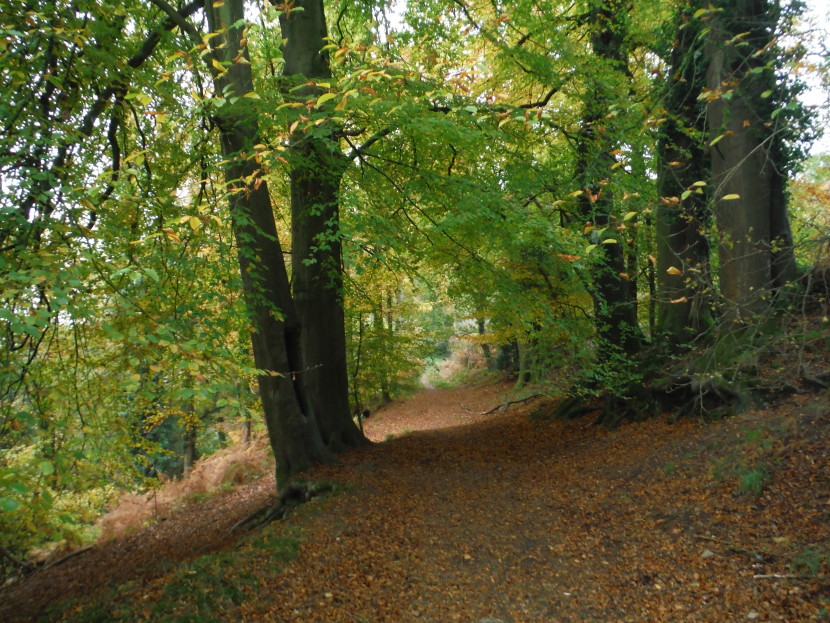 Danby beeches
Danby beeches In modern times our British storms have been given names, but not our winds, although there is a rough presumption of characteristics. Thus we know that winds from the south and west are likely to be warm and wet, but those from the north and east are cold and dry. I remember one dreadfully cold north-easterly which blew for three days one early March a few seasons ago. I was salmon fishing at Goodrich Court and every time we got out of the river we could hear little cracking noises from the skin of ice which formed within seconds on our chest waders. That particular wind was honoured by a name; “a Present from Mother Russia,” my wife christened it. She was right; on the weather chart you could see arrows pointing straight at us from the steppes.
In Madrid they famously have a “tiny wind from the sierra, which won’t blow a candle out, but can kill a man.” Even allowing for the fact that Madrid is Europe’s highest capital and was covered in snow last winter, the existence of such a deadly wind seems a bit surprising. I remember Madrid on the high Spanish plateau for its summer heat, but not for winds. There is an account of Philip II’s El Escorial palace, constructed as an expression of brutal power to dominate the landscape, having its iron framed casements driven in by a gale. But if I wanted to find winds in Spain, I would go looking for them at Atlantic Cadiz or in Cantabria.
Everybody knows the names of winds in Greece, and indeed generally throughout the Mediterranean where the classical names of winds and weather were added to or changed by Venetian and Arab seafarers. The Tramontana obviously enough comes into Greece across the northern mountains from central Europe and will be a cold one in winter. The Meltemi, a summer wind also from the north, makes for rough sailing between islands in the Aegean Sea. A Zephyr comes from the west and should be mild. Anywhere in the Mediterranean a wind from the east is a Levanter, although the Moors of Gibraltar used to refer sentimentally to the holy places of their religion and called it in Arabic the “Wind of Medina.” This was also the biblical Euroclydon which blew the Roman ship carrying St Paul out of Kali Limenes in Crete all the way to Malta. The Scirocco is a hot, choking wind from the south which comes up from Africa carrying fine sand with it from the desert. It particularly affects Crete and the Peloponnese where everybody gets into a bad temper while it blows during the summer. In Crete they used to say you had a good chance of being let off a murder charge if your defence was that you had killed while the Scirocco was blowing. The Arabs of North Africa call it Khamsin or occasionally Simoon, which means poisonous.
In days of sail on the great outer oceans, helpful tropical Trade Winds were popular with ship-owners hoping to corner the market after a fast passage. German sailors called the Trade Winds Passat, and they manned a squadron of square rigged clippers racing Australian wheat to make a good price in European markets right up to the Second World War. This was the final expression of the age of sail, four masted barques, by then steel-hulled and steel-masted, which could outrun steamers in the open oceans given the wind and skilled seamanship. Amazing as it seems, they used to make their way into the Severn and dock in the grain port of Sharpness opposite my home. I’m digressing as usual, but how on earth did they manage it? Presumably by the mid-19th century a steam tug might have been involved and very definitely the services of a skilled Bristol Channel pilot. These were known as the western men, who took specially built gaff rigged cutters crewed by a man and a boy out into the western approaches in all seasons and all weathers, to wait hove to into the wind for days or even weeks at a time for the approaching ships looking to be guided into Swansea, Cardiff, Newport or Bristol. To work in the treacherous waters of the Channel and estuary, the cutters had to be shallow of draught, fast, and capable of being sailed by a crew of two in the worst of weather. No less than 18 of these beautiful and tough little sailing vessels survive to this day. Now it is the car-makers who like to use the names of winds and there is a Volkswagen named for Passat. Even Ford managed a classical Greek name for their rather mundane Zephyr.
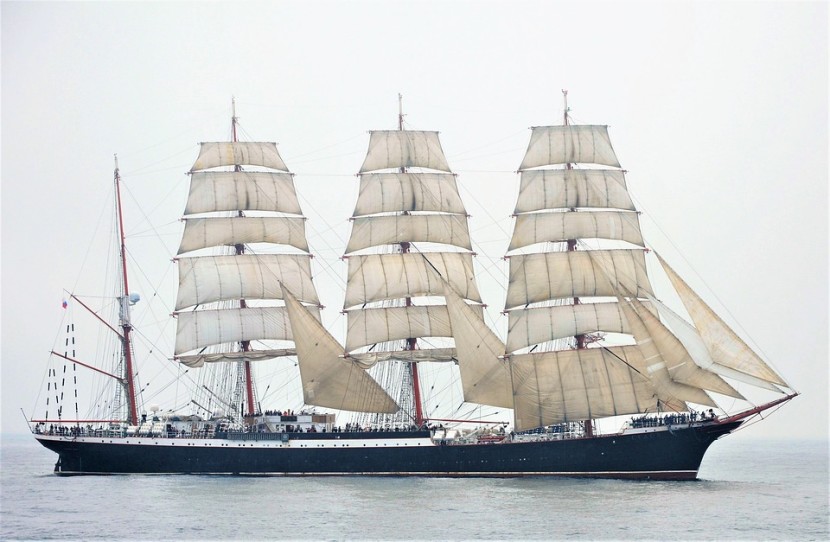 Tall ship - 4 masted barque
Tall ship - 4 masted barque 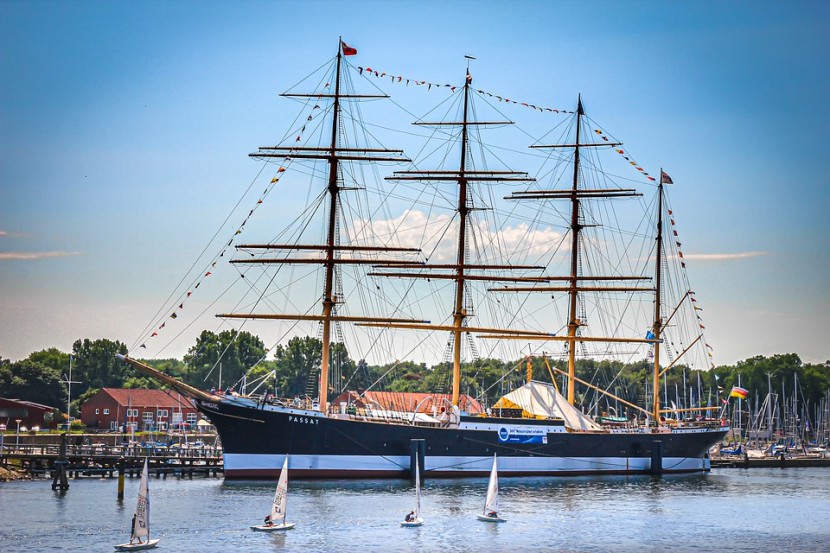 The Passat
The Passat Upper Bosnia very rarely has strong winds, although on the open western moors near the Croatian border an occasional winter blizzard blows snow drifts across the roads. Despite the fact that in this central European climate the snow arrives anywhere between October and Christmas and will certainly remain until Easter, the design of modern Bosnian houses in the style of Swiss chalets with broad overhanging eaves, is not calculated to cope with high winds. Herzegovina, just a few miles to the south beyond the Dinaric Mountains and with a mainly warm Adriatic climate, is a very different matter. Here it occasionally freezes during the winter, but rarely snows except on high mountain peaks. However, Herzegovina suffers from the Bura, which Italians call the Bora, an icy, dry winter wind which can blow from the Alps and the North Adriatic for 10 days or more at a time. Aside from the fact that a Maserati car was named after it, I can find very little good to say about the Bura. While it is blowing in Mostar, you need to lean at nearly 45 degrees to walk forward into it. Mostly people just stay home. Famously a steam locomotive heading across Mostarsko Polje towards Mostar city once ground to a halt, unable to pull a train while heading into the wind. When my wife was a girl she saw a plate glass window blown out of a shop front. Even in wartime, I don’t think there was much shooting between Muslims and Croats on the line in the city while the Bura was blowing.
While I had the humanitarian bakery in East Mostar, one winter day our driver Islam found himself trapped in his box-bodied Ford Transit after delivering bread to the outlying village of Blagaj. With 1,000 loaves in the back he had floated downwind across the open plain without too much problem, but with an empty high-sided van he could not get back. As there was no doubt in war time that an unattended vehicle would be stolen, he did not wish to leave it. Worse still, Blagaj was shelled a lot and the bread van was very likely visible from Serb positions above. Here, apart from the big guns trained on Mostar, they had mortars and at least one of the unnervingly accurate little Zis mountain guns. I was able to get down there alright in my Landrover with its heavy chassis and lent Islam a good sleeping bag. It was the least I could do, because poor Islam had to wait in the cab until the wind dropped slightly a day later in order to get back. We hadn’t seen the last of the Bura; a couple of nights after that the wind literally pushed over a high breeze block wall of the warehouse housing our mobile military bakery, damaging one of the four big diesel ovens and covering it with broken masonry. (The equipment, by the way, was a former British Army field bakery which had supposedly been deployed at Suez before it was modernised and mothballed). Until repairs were done, we had to press on with our 20 workers, making bread for a city by night in a half open building with a freezing gale blowing. Anybody who makes bread at home will know that it isn’t easy to make it rise unless conditions are warm and moist! France has its own cold wind from the north which affects the Camargue and Languedoc, but the Mistral is a milder affair by far than the Bura.
Western Afghanistan and Eastern Iran have a particularly nasty wind, this time in summer. This is known in Dari as the “120 Days Wind,” for reasons which must be obvious. I don’t think anybody would want to name a car after this one. It is a relentless wind, blowing night and day. It starts in May and goes on to September, blows up to 70 mph from north-east to south-west across the high deserts and has a hot breath as if from an open furnace door. It also carries a fine dust, like talcum powder, which driven at speed erodes the walls of mud-brick buildings and gets into everything. You can hide indoors, but not from the dust, and the nights, which you somehow hoped at first might be cooler, are made hideous by hot gusts and banging of shutters. Compared to the spring and even the winter, travelling by day becomes a particularly miserable affair. Summer travelling on dirt tracks across deserts is rarely a pleasant activity and even less so if in company with other vehicles. You quickly learn to avoid driving in columns, which results in only the occupants of the leading vehicle having clean air to breathe while everybody behind inhales a delightful mixture of fine dust and diesel smoke. Instead, it is normal on flat sections of desert to abandon the road and drive in line abreast, like a V-formation of wild geese. Our old Toyota had a weak engine, so that we had to switch the air conditioning off to enable it to climb any steep hill and would arrive at the top gasping with heat and the dust and black smoke churning around us. Air filters had to be taken out and cleaned every morning before driving. We carried spare springs for front and rear axles, but would pray that there would be no break and no associated need to change one out in the sand and the wind. Needless to relate that they did break, with monotonous regularity.
The 300 km drive down from Ghor to Herat, a city which I had to visit for co-ordination purposes roughly every 6 weeks, was a particularly long and tiring one in summer. I remember an August trip with Muktar my driver, when the day became hotter and hotter as we reached lower altitudes. Muktar stopped a couple of times to squeeze a couple of Afghanis into the hands of ancient beggars crouched by the road, their rheumy eyes protected from the blowing dust by old motorcycle goggles. Dust devils, strange twisters of brown sand and dust, began to move on either side of the road. Local people are afraid of these, believing them to be jinns or ghouls. Far away across the plain larger columns of either dust or smoke were rising. We stopped and strained our eyes for a while to see more with my binoculars. Muktar and I were uncertain whether these were sandstorms born from the hot wind, or was it that distant villages were being burned by the Taliban? The civil war was active just then, and either was a possibility. Finally, out of the brown haze ahead and below us, we made out blackish towers projecting in a square pattern. These were the minarets of Herat’s ancient mosques. At a distance from the city, strange as it may seem, this looks like nothing so much as the chimneys of the old Battersea Power Station emerging from a London fog, and we knew that day’s journey was close to an end.
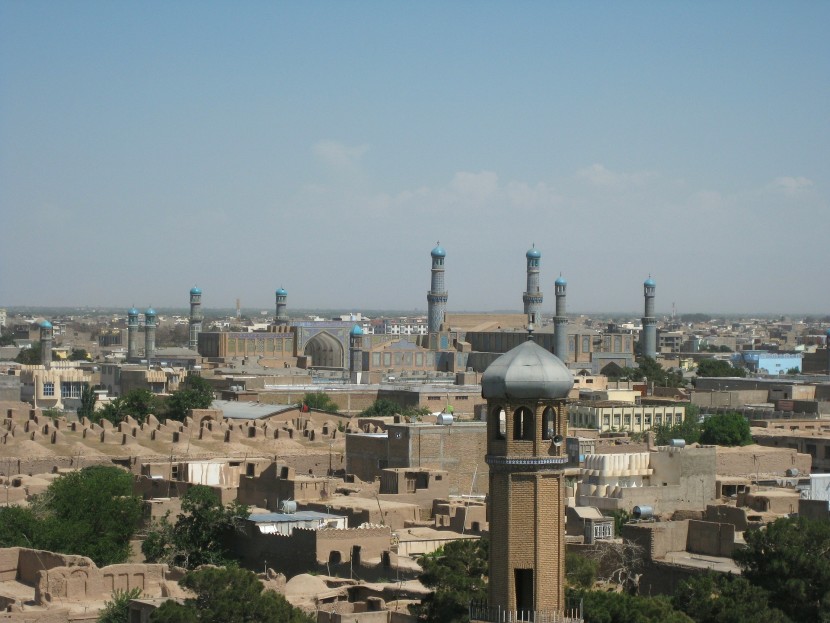 Friday Mosque of Herat
Friday Mosque of Herat 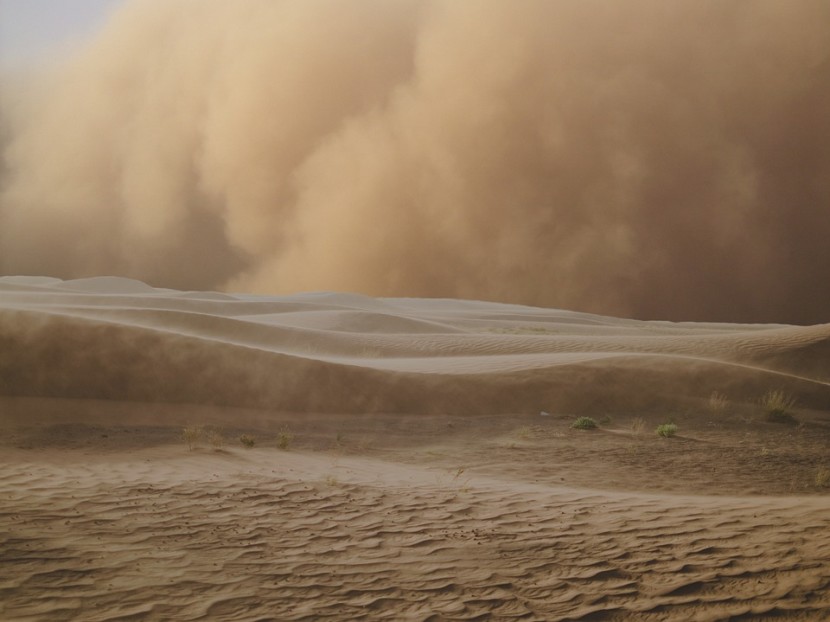 Sand storm
Sand storm Iraq is another country which suffers from sudden and massive sandstorms, particularly in the south. Before I ever worked in deserts, I asked an American colleague who had spent time in the Sahara with World Food Programme, what exactly the procedure was for sand storms. “I mean can you travel at all when the wind and dust cloud comes down?” I was asking him. “I was told travellers just have to wrap a cloth round their heads and crouch by their camels.” He gave me a quizzical look. “That’s more or less it,” he said dryly. “Only in our case we crouched by our Landcruisers.”
I have no experience of American winds, but I know that some American anglers tend to arrive in the UK with 5 weight rather than 4 weight fly rods, mainly because they are used to dealing with strong winds in the open rivers of the west. Those who can afford to go fishing for the giant sea trout of Patagonia tell us that contending with the global winds blowing unchecked around the southern oceans is the main problem. Big continents can be expected to have big winds too. Johnny Cash opened and closed one of his best songs with:
The wind blows hard across the Texas plains
Makes some people go insane
While others quietly pray for rain
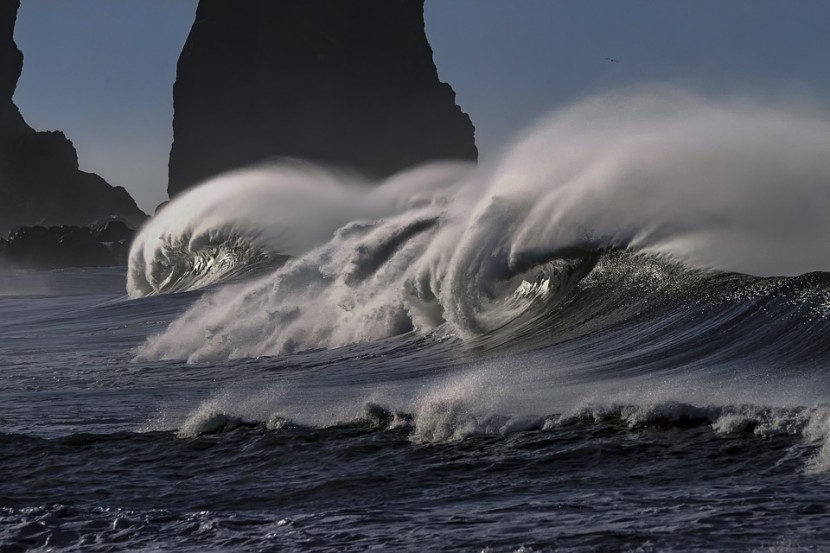
I still get a kick out of a big gale of wind. I remember childhood holidays in Dorset when we watched huge green breakers rolling over the shingle because an up-channel gale was pushing them. No swimming today! Now for a really refreshing draught of oxygen I can still button up my jacket, leave the Forest behind me, pull my hat low and walk along the raised sea wall of the Tack facing a good south-westerly blowing straight up the Bristol Channel into the mouth of the Severn. Combined with a high spring tide, these are the conditions which create a rolling bore wave where the river narrows towards Gloucester. Walking forward is a matter of leaning into the wind, ducking my head and probably grinning with the effort. In my father’s flying days – and I still see it marked on old ordnance survey maps – one of these reclaimed salt marsh fields by the estuary was designated as an emergency landing strip. How would you land a light aircraft into the wind as it is blowing today I wonder? I should imagine rather like a red kite lands into the wind, dropping gently to the ground at almost zero knots. Pegging the aircraft down before it was rolled over would be the main worry. We should be grateful, perhaps, that a British autumn storm blows out overnight or in a couple of days at the most.
 Skenfrith at the bottom of the beat
Skenfrith at the bottom of the beat 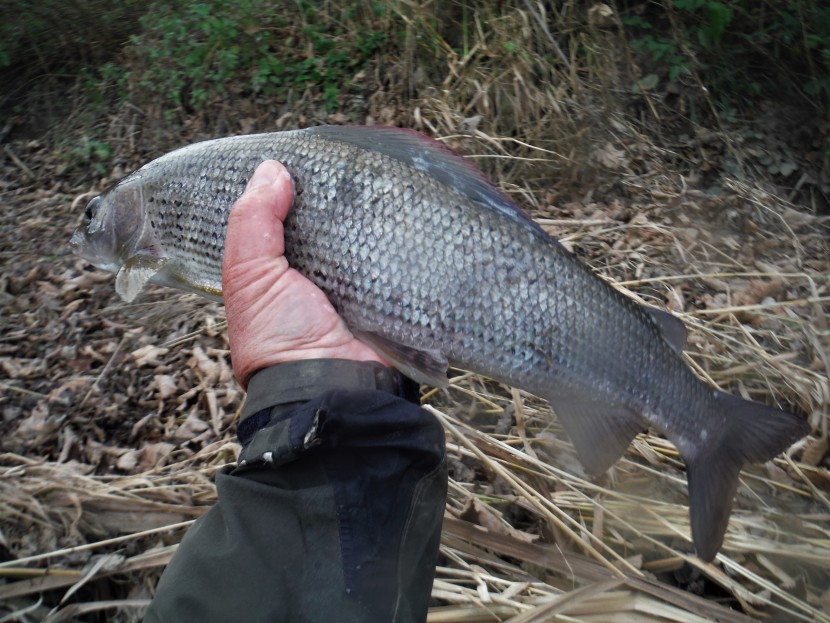 Herefordshire grayling
Herefordshire grayling So we came to the end of 2021. Spring trout fishing was spoiled for many by restrictions on freedom of movement. After that, it was a pretty rotten year for salmon and sea trout anglers. We saw some excellent grayling specimens during the autumn, but the overall numbers caught were not particularly large. Looking out now into the wider world beyond our border playground and the UK’s essentially parochial concerns, Putin is still prodding away provocatively at the European boundaries and threatening to invade Ukraine, while China looks set to do the same with Taiwan. Let’s hope the two bullies don’t act simultaneously because at the moment the disunited West is surely too weak to deal with more than one problem at a time. Meanwhile at the behest of the BBC and Sky, we in this country are apparently much more interested in whether the mince pies and wine were broken out at No 10 Downing Street on the last working day before Christmas 2020. There might even have been a quiz. “Who really cares?” was my immediate reaction to that story, but apparently people do and friends tell me I should worry about it too.
 Winter solstice dawn at Erwood
Winter solstice dawn at Erwood I expect we have all been reflecting rather ruefully on 2021. The previous year when the pandemic began, immediate personal plans such as holidays had to be set aside but somehow it didn’t seem too bad. Few of us thought that Covid would last very long. And in my case during that sunny spring of 2020 there were compensations: a rest from work and more time with the family, local walks in the Forest and barbecues during lengthening evenings. 2021 seemed much harder. Apparently the disease was returning in wave after wave. Huge amounts of money leading to future indebtedness were being spent by the Exchequer. Combative measures taken by the different nations seemed illogical and often pointless. The spring restrictions during which English visitors were banned from crossing from rural England into rural Wales for exercise in the open air impressed as particularly stupid. And yet at the same time there was every sign that our constrained economy was striving to take off. Once we had access to Wales again and with foreign holidays mostly out of reach, I and the other guides had the busiest season we have ever had. As a result - and I’m not complaining - I fished for myself less than at any time in the last 20 years. Meanwhile, anybody with any sense was busy getting themselves vaccinated, many of us for the third time. I am afraid I have no patience with those who are reluctant to be vaccinated, on the basis that not to do so is just plain selfish. Do it for the rest of society if not for yourself.
Finally, at the end of the year, here comes Omicron and the South African medics tell us very correctly and promptly that they have identified a new variant which is highly infectious and spreads more rapidly than previous versions of the disease. The rest of the world immediately punishes South Africa by cancelling flights. No-one seems to listen to the South Africans’ final remark that in their (admittedly very young) population, the new variant does not seem to be causing many hospital admissions or deaths. Now in the UK we find ourselves in a situation where Omicron is moving rapidly amongst us. At the same time, due to the progress of the disease so far and the proliferation of vaccinated persons in our society, we may be close to herd immunity. If that is right, many of us would like to get on with our lives, go back to work, and re-engage with our joys and aspirations. One could even imagine being able to visit the local health clinic (if only they would unlock the door) and see a doctor again. Or is it the case that a dangerous fourth wave is about overwhelm us and we must all don our masks and lock down in fear once more? We seem more divided on this issue even than over Brexit during the years after 2016. For now the Government in England at least, criticised as it is from all directions, has decided to hold its hand from severe lock-down measures and allow us to celebrate a fairly normal Christmas. Northern Ireland, Wales and Scotland head back toward lockdowns. Within a couple of weeks we will know who was right about the Omicron variant.
Happy New Year to everybody, despite all the problems, and let’s hope for a more normal life in 2022.
Oliver Burch
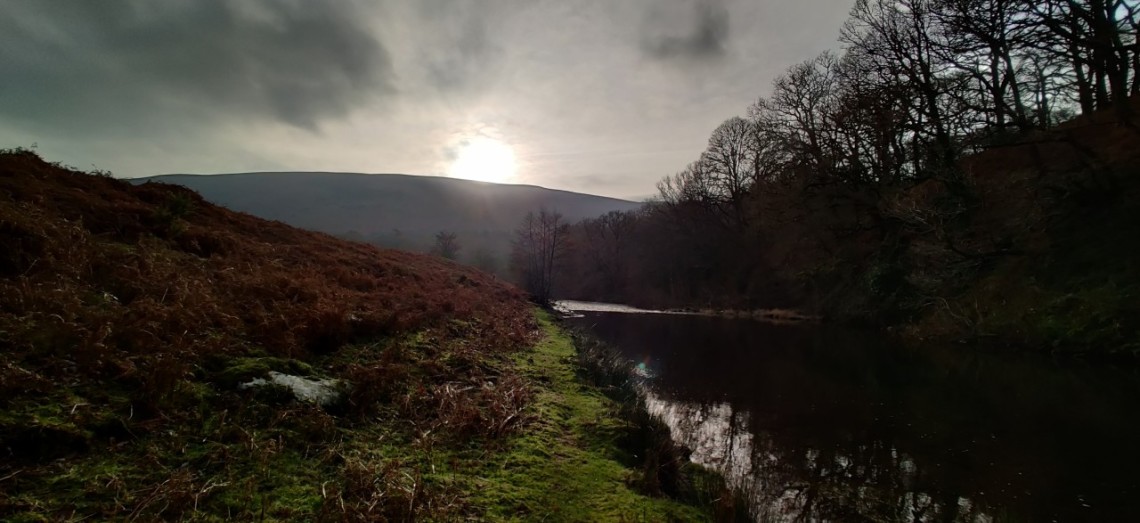 Craig Llyn - LB from Bath
Craig Llyn - LB from Bath